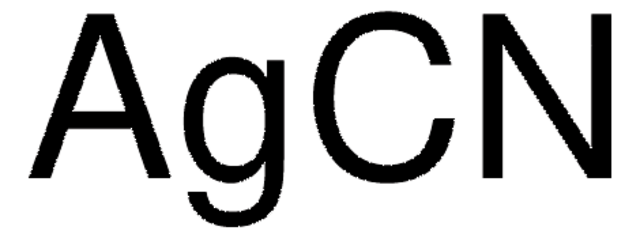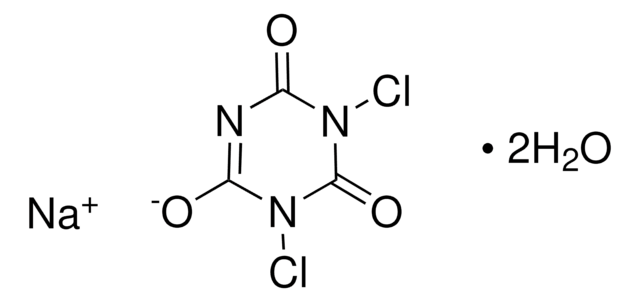Kluczowe dokumenty
379867
Potassium dicyanoaurate(I)
99.95% trace metals basis
Synonim(y):
Gold (I) potassium cyanide, Potassium gold cyanide
About This Item
Polecane produkty
klasa czystości
for analytical purposes
Próba
99.95% trace metals basis
Formularz
crystalline
zanieczyszczenia
≤550.0 ppm Trace Metal Analysis
gęstość
3.45 g/mL at 25 °C (lit.)
ciąg SMILES
[K+].N#C[Au-]C#N
InChI
1S/2CN.Au.K/c2*1-2;;/q;;-1;+1
Klucz InChI
OQHPFUBKFKRHKZ-UHFFFAOYSA-N
Szukasz podobnych produktów? Odwiedź Przewodnik dotyczący porównywania produktów
Opis ogólny
Zastosowanie
- Do przygotowania elektrod z nanodrutów złota o szybkim przenoszeniu ładunku.
- Jako elektrolit pomocniczy do elektroosadzania złota w mediach organicznych.
- Do przygotowania czujników gazowych polipirol-ClO4 o krótkim czasie reakcji i wysokiej czułości na lotne związki organiczne.
- W elektrochemicznym przygotowaniu kompozytów nanocząstek złota.
Hasło ostrzegawcze
Danger
Zwroty wskazujące rodzaj zagrożenia
Zwroty wskazujące środki ostrożności
Klasyfikacja zagrożeń
Acute Tox. 1 Dermal - Acute Tox. 2 Inhalation - Acute Tox. 2 Oral - Aquatic Acute 1 - Aquatic Chronic 1
Zagrożenia dodatkowe
Kod klasy składowania
6.1B - Non-combustible acute toxic Cat. 1 and 2 / very toxic hazardous materials
Klasa zagrożenia wodnego (WGK)
WGK 3
Temperatura zapłonu (°F)
Not applicable
Temperatura zapłonu (°C)
Not applicable
Środki ochrony indywidualnej
Eyeshields, Faceshields, Gloves, type P3 (EN 143) respirator cartridges
Wybierz jedną z najnowszych wersji:
Masz już ten produkt?
Dokumenty związane z niedawno zakupionymi produktami zostały zamieszczone w Bibliotece dokumentów.
Nasz zespół naukowców ma doświadczenie we wszystkich obszarach badań, w tym w naukach przyrodniczych, materiałoznawstwie, syntezie chemicznej, chromatografii, analityce i wielu innych dziedzinach.
Skontaktuj się z zespołem ds. pomocy technicznej




![Roztwór wzorcowy cyjanku traceable to SRM from NIST K₂[Zn(CN)₄] in H₂O 1000 mg/l CN Certipur®](/deepweb/assets/sigmaaldrich/product/images/920/032/af45eec3-100b-4996-8eb3-c3942d441bc9/640/af45eec3-100b-4996-8eb3-c3942d441bc9.jpg)





